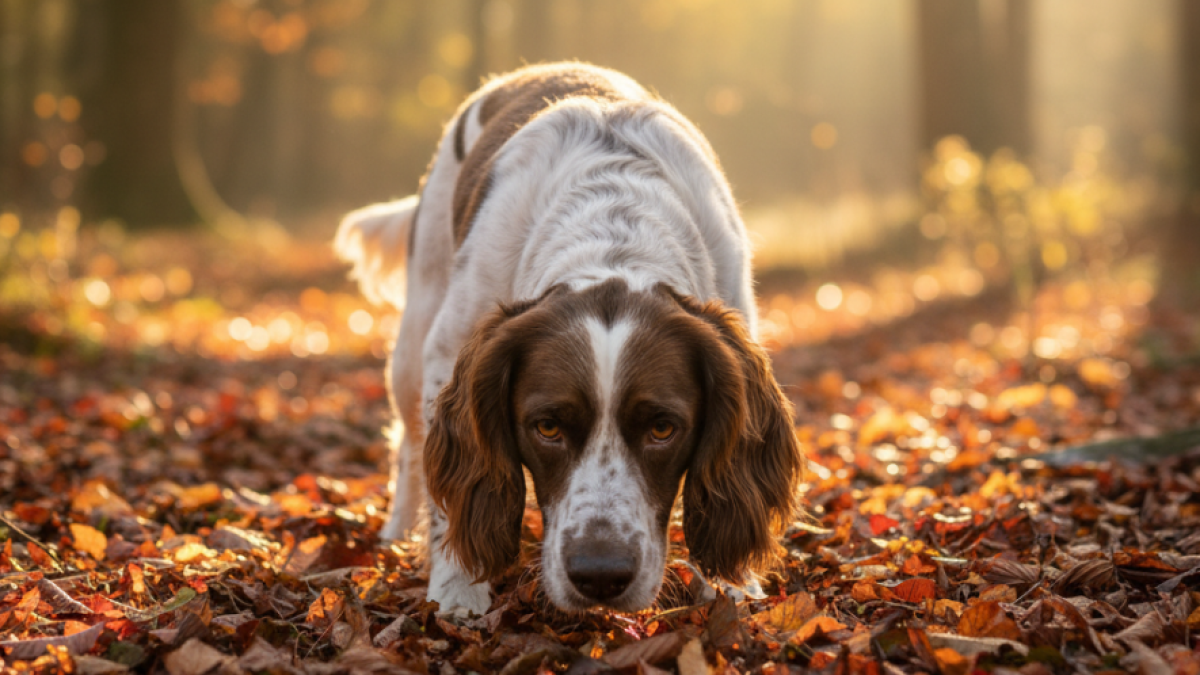Week 2🐾 Blog Title: Scent, Scents Everywhere – Understanding the Autumn Nose

Autumn is full of scent and distraction. Learn how to work with your dog’s nose, not against it, to build focus, trust, and connection.
🍁 Blog: Scent, Scents Everywhere – Understanding the Autumn Nose
If autumn had a signature, it would be scent.
The damp ground, fallen leaves, and earthy air carry stories that our dogs can read like a novel — one written in pheasant tracks, rabbit trails, and hidden treasures.
For us, this season can sometimes feel like our dogs have forgotten everything we’ve taught them. That perfect recall? Gone. That steady heel? Suddenly optional. But in truth, your dog hasn’t stopped listening — they’re just busy processing the world through their nose.
This week in our “A Year in the Life of a Gundog – From Field to Firelight” series, we’re looking at how to work with your dog’s natural instincts, rather than against them, to build focus, patience, and a better understanding of scent.
🐶 Why Autumn Sends the Nose Into Overdrive
Cooler temperatures hold scent close to the ground, and moisture in the air helps it travel further.
Every gust of wind carries invisible information — what’s been here, how long ago, and which direction it went.
For spaniels, this triggers their natural hunting drive. For retrievers, it stirs their tracking and marking instincts. It’s not disobedience; it’s biology in action.
When we recognise this, we can turn distraction into opportunity.
🌿 Working With the Nose
Instead of fighting the pull of scent, teach your dog that checking in with you makes the game more rewarding.
Here are some simple ways to harness scent positively:
-
Scented Recall:
On a walk, let your dog investigate a scent. Then call them back cheerfully. When they return, reward generously. They learn that exploring scent and returning to you both have value. -
Hunt Together:
Scatter a few treats or a small toy in grass or leaves. Encourage your dog to use their nose to find it while you stay involved. This builds teamwork — your dog learns that scenting with you is fun. -
Scent Swaps:
Let your dog sniff a dummy before a retrieve, helping them understand what they’re looking for. Later, this becomes invaluable for hunting blinds or finding cold game.
Each of these games teaches your dog to use their natural ability in a controlled, rewarding way.
🧠 Reading Your Dog
Learning to read your dog’s body language while they scent is a vital skill.
-
A high nose usually means they’re catching scent on the wind (air-scenting).
-
A low nose and zig-zag pattern means they’re following ground scent.
-
A pause and flick of the head may show they’ve hit a strong scent line.
When you observe, rather than interrupt, you learn to anticipate what they’re about to do — an invaluable skill once you’re working in the field.
💡 Keep It Balanced
While scentwork is brilliant for engagement, too much unstructured sniffing can make focus difficult.
Balance free exploration with short focus games — such as recall, heelwork, or a short retrieve — to help your dog learn to switch between work and play.
As always, keep sessions short and successful. Young dogs especially can become overstimulated and lose focus if scenting goes on too long.
❤️ Final Thought
A gundog’s nose is its greatest asset — and your best training tool.
By giving your dog appropriate outlets to use it, you’ll find they become calmer, more fulfilled, and far more connected to you.
Next week, we’ll explore “The Power of Calm” — how rest and relaxation underpin everything from steadiness to confidence.
Categories: : Autumn Series
 Sue Watkins
Sue Watkins 